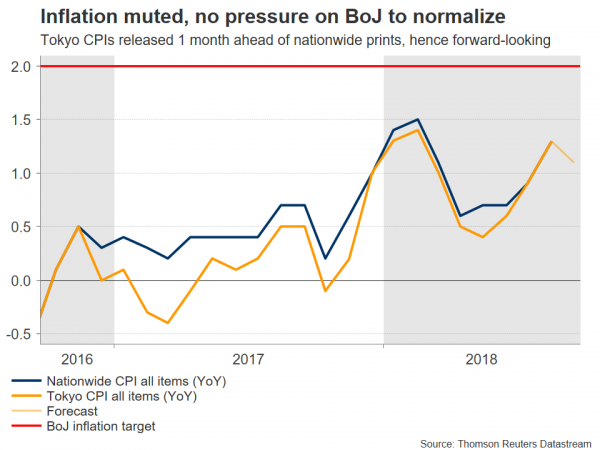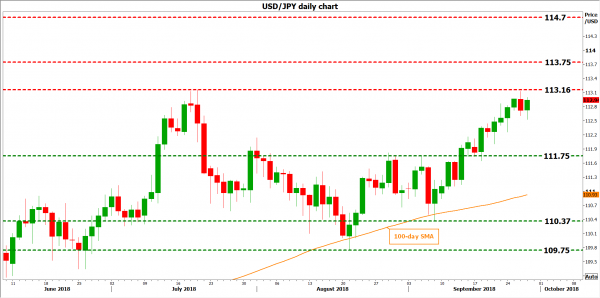A raft of economic data out of Japan will hit the markets on Thursday at 2330 GMT. Forecasts point to numbers that would reaffirm the BoJ’s reluctance to consider an exit from its massive stimulus program for the time being and as such, are unlikely to have much impact on the yen. Instead, the far bigger driver for the currency is likely to be any change in investors’ risk appetite amid growing trade tensions.
It’s going to be a busy end to the week in Japan. The Tokyo CPI readings for September are expected to confirm inflation in the Japanese capital remains tepid. The headline CPI rate is projected to cool to an annual pace of 1.1%, from 1.2% previously, while the core figure that excludes fresh food is anticipated to hold steady at 0.9%. The Tokyo CPIs are considered forward-looking gauges of the nationwide prints and hence, are crucial for Bank of Japan (BoJ) decision-making. Employment data, which will be released at the same time, are forecast to confirm that the labor market remains robust. The unemployment rate is expected to have remained unchanged at 2.5% in August, while the jobs-to-applicants ratio is also seen flat at 1.63, a four-decade high.
Twenty minutes later, at 2350 GMT on Thursday, Japan’s industrial production and retail sales data for August will hit the markets. Industrial production is projected to have rebounded to 1.5% in monthly terms, after falling by 0.2% previously, while retail sales are projected to have accelerated to 2.2% on an annual basis, from 1.5% in the month prior. Alongside these, the BoJ will release the Summary of Opinions from its latest meeting, where it kept its ultra-loose policy framework intact, providing no signals it will alter it anytime soon. Investors will probably scrutinize the Summary for any hints on whether policymakers may eventually consider dialing back stimulus, particularly in light of recent concerns by some officials regarding the growing adverse effects of their massive money-printing program.
As for the yen, Japanese data usually have only a negligible impact on the currency. To explain why, it’s fruitful to consider the example of another central bank, for instance the Fed. When US data show improvement, markets bet for a faster pace of rate hikes by the Fed, pushing the dollar higher (and vice versa). Contrast this with the BoJ, which isn’t expected to adjust its policy at all in the foreseeable future. Hence, investors don’t rush to either buy or sell the yen on data releases that probably won’t have enough of an impact to make the BoJ alter its policy. In other words, while a dramatic improvement in Japanese data could see gains in the yen on BoJ-normalization speculation, anything short of that tends to be overlooked as simply confirming the “no policy change in sight” narrative.
Instead, the yen responds much more to changes in global risk sentiment, given its safe-haven status. When trade tensions between the US and the rest of the world heat up for example, the currency typically attracts inflows. While investors seem to have largely brushed aside such concerns in recent days, any further escalation in the trade skirmish moving forward could still trigger some rebounds in the yen. That said, if price action in recent months is any guide, any such bounces may remain relatively short-lived, providing only temporary relief to the Japanese currency.
Technically, advances in dollar/yen could encounter immediate resistance around the 9-month peak of 113.16, with a break above that zone possibly paving the way for a test of 113.75, a high last seen on December 12. Higher still, bullish extensions could stall near the November 6 top of 114.70.
Conversely, a pullback in the pair may find preliminary support at 111.75, the area that halted the rally on September 5. A downside violation could shift the attention to the September 7 trough of 110.37, before the August 21 low at 109.75 comes into view.
















